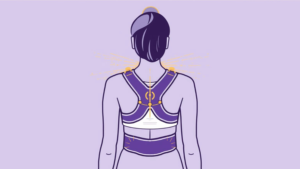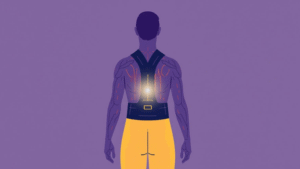Picture waking up stiff in your neck or with a nagging ache in your lower back after what seemed to be an adequate night’s sleep. This is a common experience for many on-the-go working professionals, like providers, corporate professionals, or someone managing family life and personal health! While we may look to other components of daily living such as excessive screen time and undue stress, we often forget about the role we play when we sleep, namely sleeping posture, and how that may contribute to having our spines feel the way they do in the morning. After all, when we choose to lay down when we sleep, that act and choice can contribute to potential long-lasting issues with the health of our spine that can lead us down the rabbit hole of chronic pain if it goes unaddressed. Recognizing whether you sleep on your back, sides, or abdomen and how that position can influence the alignment of your spine is significant in our organization of our health overall [1].
Why Does Sleep Position Matter for Spine Health?
Understanding Spinal Alignment During Sleep
The natural curvature of the spine is an important part of the body to support weight and movement. It is important to preserve that alignment during sleep to mitigate stresses on spinal structures. Misaligning the spine can cause the muscles, joints, and nerves to experience more strain than they need to operate in sleep [2].
Role of the Spine in Overall Health
The spine not only provides structural support for the body but encompasses the central nervous system that regulates most bodily functions. If the alignment of the spine is disrupted, nerve signaling may be compromised; this could impair everything from mobility to the functionality of an organ. Therefore, safeguarding the integrity of spinal health while we sleep is important for our physical health and well-being, not only for comfort [3].
What Are the Common Sleeping Positions and Their Impact?
Back Sleeping (Supine Position)
Pros and Cons
Sleeping on your back is usually accepted as one of the best positions for the spine. We are able to distribute our body weight evenly along the spine and reduce the chance of misalignment, while reducing pressure on the back muscles and joints to maintain the normal curves of the cervical, thoracic, and lumbar spine. [4] This does not mean sleeping on our back is the best position for everyone. It may make conditions worse for snorting and obstructive sleep apnea because the tongue and soft tissue can collapse backward in the throat and cause an obstruction of the airway [4].
Best Pillow and Mattress Suggestions
A medium-firm mattress provides the ideal harmony of support and comfort, and allows the spine to maintain its natural S-shaped curve. For pillows, use either a cervical pillow or a thin pillow that supports the neck without elevating the head too much (especially for back and side sleeping positions). A small pillow between the knees can relieve tension in the lower back by promoting a more natural pelvic tilt [5].
Side Sleeping (Lateral Position)
Benefits for Digestion and Snoring
Side sleeping is the most preferred position and a particularly good option for people with digestive or reflux issues. In particular, sleeping on your left is best for digestion and acid reflux because gravity will help to keep your stomach acids in place [6]. Also, sleeping on one’s side helps reduce snoring and mild sleep apnea symptoms by ensuring a more open airway and reduced compression of airway structures [6].
Impact on Shoulder and Hip Pressure
Side sleeping can come with a variety of advantages but can increase pressure on your shoulder and hip on the side you are lying down on. Over time, this pressure could lead to discomfort, numbness, and stiffness of the joint if you do not support the points of pressure.
How to Avoid Spinal Curvature
To maintain a neutral spinal alignment, selecting a pillow that keeps the head aligned with the spine while filling the space between the head and the mattress is important, with a firmer pillow will keep the head aligned with the spine. When you sleep with a pillow between your knees, you prevent the top leg from pulling the spine out of alignment which lessens the strain on the lower back and hips [6]. If you tend to switch sides throughout the night, try to maintain a consistent posture to avoid uneven wear on the spine.
Stomach Sleeping (Prone Position)
Negative Effects on the Neck and Spine
Though some individuals enjoy sleeping on their stomachs, it is often not the best position for spinal health overall. Sleeping on your stomach will flatten the natural curve of your lower spine and put too much stress on the lumbar area [7]. In addition, and possibly even more harmful, sleeping on your stomach forces the neck into a rotated position to the side and stays there for a long while, which can create neck stiffness and pain.
Impact on Breathing and Organ Function
Sleeping on your stomach also restricts diaphragmatic breathing as the pressure in the chest and abdomen increases, which may reduce the body’s range of deep, restorative breathing while sleeping.
Tips to Reduce Strain If You Can’t Avoid It
If stomach sleeping is a difficult habit to break, try a very thin pillow (or no pillow) to minimize the degree of neck rotation. You may want to put a pillow under your hips or lower abdomen to decrease strain on the lower back, and help keep your spine aligned [7].
Fetal Position
Suitable for Certain Conditions
The fetal position, which means you sleep on your side with your knees pulled toward your chest, can be valuable for specific health conditions. For example, it decreases pressure on spinal discs for those who suffer from herniated discs or sciatica, as it opens up the spaces between the vertebrae, causing a gentle decompression effect [8]. Also, this position is also frequently recommended for pregnant women because it increases circulation to the baby.
Risk of Over-Curving the Spine
Yet, if the body curls up too tightly, it may limit diaphragmatic breathing and contribute to stiffness in the back and hips [8]. This is especially so if the shoulder hunched forward to an excess, causing the upper spine to round resulting in discomfort of the shoulders.
Tips for Healthy Fetal Position Sleeping
To sleep comfortably in a fetal position without exaggerating the curve of the spine, allow the spine to stay as straight as possible instead of tucking too tightly. A pillow between the knees will support hip and spinal alignment, while a firmer pillow for the head will allow for a neutral support position of the neck.
Combination Sleeping
Dynamic Position Shifts During the Night
A lot of individuals change positions frequently during sleep by repeatedly rolling from back to either side and/or stomach. There is nothing wrong with some movement while sleeping, and movement during sleep contributes to circulation. However, consistently or erratically changing positions can occasionally result in temporary changes to spinal alignment, or aggravate pain if you already have existing spinal issues.
Supporting Spinal Health as a Combination Sleeper
If you are a combination sleeper, look for something like either a memory foam or a hybrid mattress that are able to accommodate movement and different needs for support. Use a neutral pillow, neither thick nor thin, that will allow your head and neck to maintain alignment as you change sleep positions.
What Are the Long-Term Effects of Poor Sleeping Posture?
Chronic Back and Neck Pain
Consistently poor sleeping position can put too much and uneven stress on the muscles, ligaments, and joints of the spine. Over time, the excessive strain can result in chronic musculoskeletal-related pain in the neck and back region leading to morning stiffness, a limited range of motion, and discomfort that continues throughout the day. Misalignment can accumulate over time and set conditions for developing muscle spasms, disc degeneration, and possibly causing more serious spinal pathologies (e.g., herniated discs, spinal stenosis, etc.) [9]. Chronic pain can also create a cycle of poor sleep as pain can make sleeping in a rested posture difficult, which causes more discomfort and sleep.
Postural Imbalance and Misalignment
Over time, sleeping in poor sleep postures may result in some postural imbalances, such as forward head posture, rounded shoulders, and pelvic tilt. Postural imbalances may become habitual in our daily lives, contributing to poor ergonomics during our work, exercising, and aggravating spinal alignment issues. Instead of balanced loading of the spine, sleeping on one side of your body will cause asymmetrical loading of the spine and will cause one or two muscle groups to continually over-recruit and become tight while other groups weaken and lose function. This creates a muscle imbalance that alters the curves within the spine [9]. Muscle imbalances affect everything from how we stand to how we walk, and to how we move when performing physical activity.
Impact on Nerve Health and Sleep Quality
When the spine is not aligned while you sleep, creating pressure and/or irritation on the nerves that travel through and around the spinal vertebrae, it can create symptoms like numbness, tingling, or shooting pain in the extremities, more so in the case of pinched nerves or nerve impingement [10]. Poor spinal alignment can also reduce the circulation and cause restless sleep, waking up; and if this happens continuously, it disrupts the sleep cycles and oxygen, and can affect the restorative process of sleep, e.g. deep and REM sleep, core functions of repairing and healing tissue, consolidate memory, brain function, mental health, immune function; over time this accumulates, with lack of sleep, contributing to chronic fatigue; increase incidence of sleep disturbance; decreased energy; impaired concentration; affect mood, and brain alertness; etc.
Potential Impact on Breathing and Circulation
Sometimes, sleeping in a poor position, especially fetal or face-down positions can limit the ability to breathe diaphragmatically. Shallow breathing can decrease the flow of oxygen and lead to the feelings of fatigue and sluggishness during the day. Plus, the pressing of certain blood vessels can limit blood flow, sometimes resulting in swelling or discomfort in limbs.
Increased Risk of Spinal Degeneration
The effects of poor sleeping posture can accumulate cumulatively over a number of years leading to wear and tear in your spine. This may increase the chance of degenerative conditions, like osteoarthritis or degenerative disc disease, particularly if combined with other risk factors such as age and activity level.
What Are Expert Tips for Spinal-Friendly Sleep?
Choosing the Right Mattress and Pillow
Selecting a mattress that supports the natural curvature of the spine is crucial. Medium-firm mattresses are often recommended for spinal support [5]. Pillows should keep the head aligned with the spine; the appropriate type varies depending on sleep position [11].
Ergonomic Sleep Habits to Adopt
- Maintain a consistent sleep schedule to regulate circadian rhythms.
- Engage in regular physical activity to strengthen muscles supporting the spine.
- Practice relaxation techniques before bed to reduce muscle tension [12].
When to Consult a Spine Specialist
If experiencing persistent back or neck pain, numbness, or tingling, it’s advisable to consult a healthcare professional. Early intervention can prevent further complications and aid in developing a tailored treatment plan [13].
Final Thoughts on Protecting Your Spine While Sleeping
Understanding the impact of sleep positions on spinal health is essential for preventing chronic pain and maintaining overall well-being. By adopting proper sleep postures and investing in supportive bedding, individuals can enhance sleep quality and spinal alignment, leading to improved daily functioning and quality of life [14].
References
- Cary, D., Jacques, A., & Briffa, K. (2021). Examining relationships between sleep posture, waking spinal symptoms and quality of sleep: A cross-sectional study. PLOS ONE, 16(11), Article e0260582. https://doi.org/10.1371/journal.pone.0260582 PLOS
- Mayo Clinic. (2024, January 19). Sleeping positions that reduce back pain. Mayo Clinic. Retrieved August 25, 2025, from https://www.mayoclinic.org/diseases-conditions/back-pain/in-depth/sleeping-positions/art-20546852 Mayo Clinic
- National Spine Health Foundation. (n.d.). Sleeping and the spine. Retrieved August 25, 2025, from https://spinehealth.org/article/sleeping-and-the-spine/ National Spine Health Foundation
- Sleep Foundation. (2025, August). What to know about sleep posture. Sleep Foundation. Retrieved August 25, 2025, from https://www.sleepfoundation.org/sleeping-positions/sleep-posture Sleep Foundation
- Keck Medicine of USC. (n.d.). The best — and worst — sleep positions for back pain. Retrieved August 25, 2025, from https://www.keckmedicine.org/blog/the-best-and-worst-sleep-positions-for-back-pain/ Keck Medicine of USC
- UR Medicine. (n.d.). Good sleeping posture helps your back. URMC Encyclopedia. Retrieved August 25, 2025, from https://www.urmc.rochester.edu/encyclopedia/content?ContentID=4460&ContentTypeID=1 University of Rochester Medical Center
- U.S. National Library of Medicine. (2025). Relationship between sleep posture and low back pain [Review]. PubMed. Retrieved August 25, 2025, from https://pubmed.ncbi.nlm.nih.gov/40338112/ PubMed
- Southeast Texas Spine Institute. (n.d.). Is your sleeping position harming your spine? Retrieved August 25, 2025, from https://www.southeasttexasspine.com/blog/is-your-sleeping-position-harming-your-spine Southeast Texas Spine























